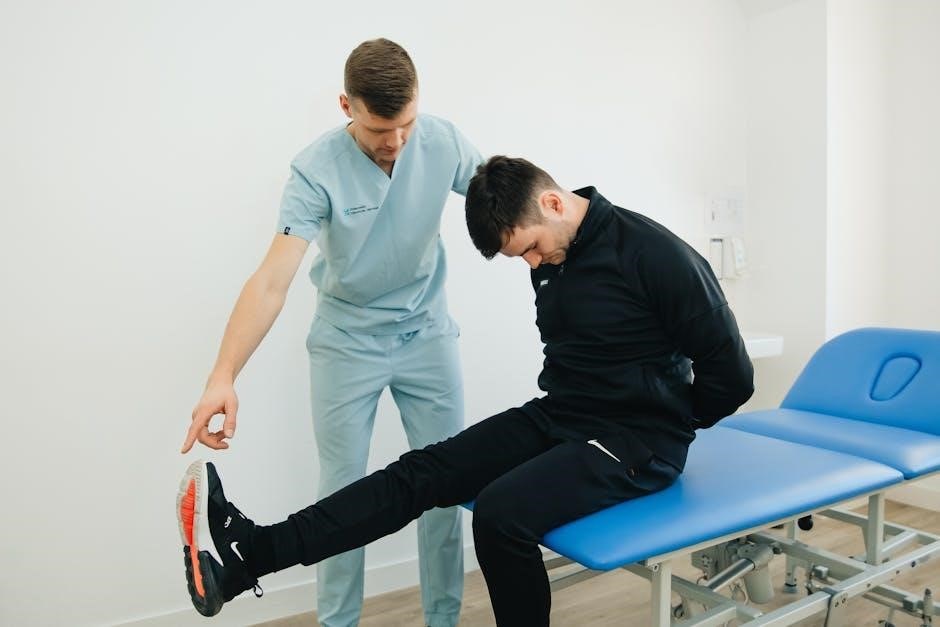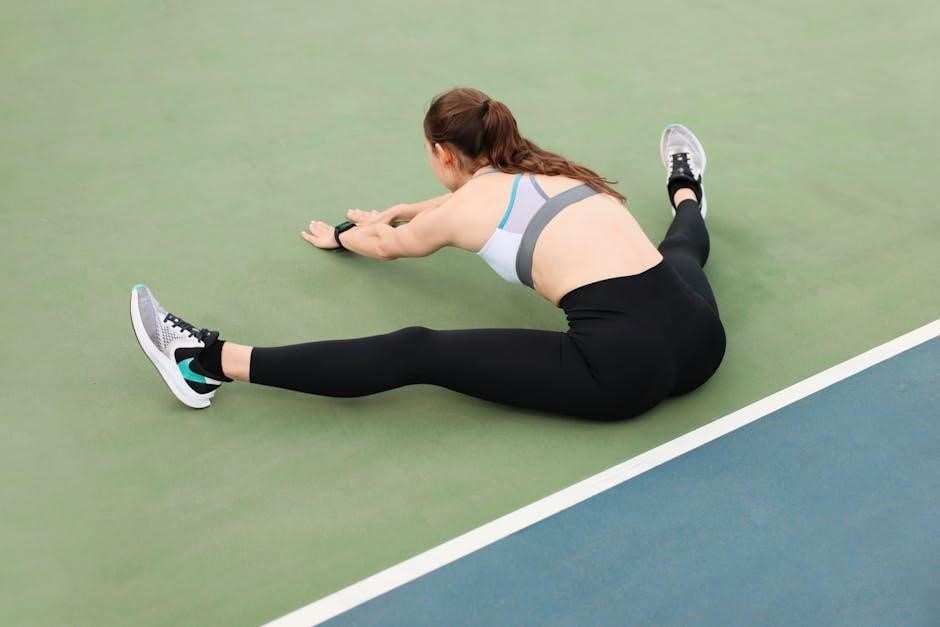Sciatica is a common condition causing pain, numbness, and tingling along the sciatic nerve, often due to a herniated disc or muscle tightness. Stretching exercises are a non-invasive way to alleviate symptoms by improving flexibility and reducing discomfort. Consistency is key for long-term relief.

Benefits of Stretching for Sciatica
Stretching exercises offer numerous benefits for managing sciatica, particularly by targeting tight muscles like the piriformis and hamstrings. These exercises improve flexibility, reduce discomfort, and promote healing. Regular stretching can alleviate pain, numbness, and tingling by relieving pressure on the sciatic nerve. It also enhances mobility, making daily activities easier. Additionally, stretching strengthens core and glute muscles, which helps stabilize the lower back and prevent future flare-ups. Consistency is key, as regular practice can lead to long-term relief. Many find that incorporating a morning and evening routine, even just 10 minutes, significantly reduces symptoms. Stretching is a non-invasive approach, making it an ideal first step for managing sciatica. A downloadable sciatica stretching exercises PDF provides easy access to effective routines, allowing individuals to manage symptoms and enhance mobility from home. By combining stretching with lifestyle changes, such as proper posture and regular movement, individuals can effectively alleviate sciatic nerve pain and improve overall well-being;

Best Stretching Exercises for Sciatica
The most effective stretches for sciatica include the Knee to Chest Stretch, Figure-4 Stretch, Piriformis Stretch, Cat-Cow Stretch, Glute Bridge, and Hamstring Stretch. These exercises target tight muscles, improve flexibility, and relieve pressure on the sciatic nerve, helping to alleviate pain and enhance mobility.
3.1 Knee to Chest Stretch
The Knee to Chest Stretch is a simple yet effective exercise for sciatica relief. To perform this stretch, lie on your back with both knees bent. Gently grab the back of one thigh and pull your knee toward your chest until you feel a comfortable stretch in your lower back and buttocks. Hold this position for 8-10 seconds, then release. Repeat the stretch 3 sets on each side.
This exercise targets the piriformis muscle and helps relieve tension in the sciatic nerve. It is particularly beneficial for individuals experiencing pain radiating down the back of the leg. Consistency is key, as regular practice can significantly reduce sciatica symptoms. For those with severe pain, modifying the stretch by holding the shin instead of the thigh can be less intense. Always prioritize gentle movements to avoid aggravating the condition.
By incorporating the Knee to Chest Stretch into your daily routine, you can improve flexibility, reduce discomfort, and promote healing. Remember to breathe deeply during the stretch to enhance relaxation and effectiveness.

3.2 Figure-4 Stretch
The Figure-4 Stretch is an excellent exercise for targeting the piriformis muscle, which often contributes to sciatica pain. To perform this stretch, lie on your back and cross one ankle over the opposite knee, forming a “figure-4” shape. Gently pull the unaffected leg toward your chest until you feel a stretch in the buttocks of the affected side. Hold this position for 8-10 seconds, then release. Repeat 3 sets on each side.
This stretch is particularly effective because it directly addresses tightness in the piriformis muscle, a common cause of sciatic nerve irritation. By relaxing this muscle, the Figure-4 Stretch helps reduce pressure on the sciatic nerve, alleviating pain and discomfort. For those with severe pain, a modified version can be done by holding onto the thigh instead of the ankle or using a strap for assistance.
Regular practice of the Figure-4 Stretch can improve flexibility, reduce muscle tension, and enhance overall lower back mobility. It is a simple yet powerful addition to any sciatica relief routine, promoting long-term comfort and preventing future flare-ups.
3.3 Piriformis Stretch
The Piriformis Stretch is a highly effective exercise for alleviating sciatica symptoms, as it targets the piriformis muscle, which often compresses the sciatic nerve. To perform this stretch, lie on your back and place the affected leg over the other thigh, forming a “figure-4” position; Gently pull the unaffected leg toward your chest until you feel a stretch in the buttocks of the affected side. Hold for 8-10 seconds, then release. Repeat 3 sets on each side.
This stretch is particularly beneficial because it directly addresses tightness or spasms in the piriformis muscle, a common cause of sciatic nerve irritation. By relaxing this muscle, the Piriformis Stretch helps reduce pressure on the sciatic nerve, providing relief from pain and discomfort. For those with limited mobility, a seated version of this stretch can be performed by crossing the affected leg over the other thigh and leaning forward slightly.
Regular practice of the Piriformis Stretch can improve flexibility, reduce muscle tension, and enhance overall lower back mobility. It is a simple yet powerful addition to any sciatica relief routine, promoting long-term comfort and preventing future flare-ups. This exercise can be done at home and is a great way to maintain muscle balance and reduce sciatica-related pain.
3.4 Cat-Cow Stretch
The Cat-Cow Stretch is a gentle and effective exercise for improving spinal mobility and relieving sciatica symptoms. It targets the lower back and pelvis, helping to reduce stiffness and improve flexibility. To perform this stretch, start on your hands and knees in a tabletop position. Inhale as you arch your back, lifting your head and tailbone toward the ceiling (Cow Pose). Then, exhale as you round your spine, tucking your chin and pelvis toward the floor (Cat Pose). Repeat this sequence 8-10 times, moving slowly and smoothly.
This stretch is particularly beneficial for sciatica because it promotes movement and relaxation in the lower back, where the sciatic nerve is often compressed. By improving spinal flexibility, the Cat-Cow Stretch can help reduce pressure on the sciatic nerve and alleviate pain. It is also a low-impact exercise, making it suitable for individuals with limited mobility or those who are just starting their sciatica relief journey.
Incorporating the Cat-Cow Stretch into your daily routine can enhance spinal health and provide long-term relief from sciatica symptoms. Its simplicity and effectiveness make it a popular choice for managing sciatic nerve discomfort and improving overall back mobility. Regular practice can lead to better posture, reduced stiffness, and a significant reduction in sciatica-related pain.
3.5 Glute Bridge
The Glute Bridge is an excellent exercise for strengthening the glutes and relieving sciatica symptoms. It helps activate the gluteal muscles, which are often underactive in individuals with sciatica, reducing the lower back’s compensatory overwork. To perform the Glute Bridge, lie on your back with knees bent and feet flat on the floor. Arms can rest at your sides, palms down. Engage your core by pulling your belly button toward your spine for stability.
Slowly lift your hips toward the ceiling by squeezing your glutes, forming a straight line from knees to shoulders. Hold the position for 2-3 seconds at the top, then lower your hips back down without arching your back. Aim for 3 sets of 10-15 repetitions. This exercise not only strengthens the glutes but also improves pelvic alignment and reduces pressure on the sciatic nerve.
Proper form is crucial to avoid straining the lower back. Focus on using your glutes to lift rather than your back muscles. Incorporating the Glute Bridge into your routine can enhance spinal stability and provide significant relief from sciatica-related discomfort. Regular practice strengthens the muscles that support the spine, promoting long-term pain relief and improved mobility.
3.6 Hamstring Stretch
The Hamstring Stretch is a simple yet effective exercise for relieving sciatica symptoms caused by tight hamstrings. Tightness in the hamstrings can pull on the pelvis, exacerbating sciatic nerve irritation. This stretch targets the back of the thighs, promoting flexibility and reducing discomfort.
- Sit on the floor with your legs straight out in front of you.
- Lean forward from your hips, reaching for your toes or shins, until you feel a gentle stretch in the back of your legs.
- Hold the stretch for 20-30 seconds, then release.
- Repeat 2-3 times for optimal results.
Performing the Hamstring Stretch regularly can help alleviate sciatica pain by reducing muscle tension and improving circulation. It’s a low-impact exercise that can be done at home, making it an ideal addition to your daily routine. Consistency is key to experiencing long-term benefits and preventing future flare-ups. This stretch is particularly beneficial for individuals who spend extended periods sitting or have tightness in the lower extremities. By incorporating it into your stretching regimen, you can effectively manage sciatica symptoms and enhance overall lower body flexibility.

Lifestyle Modifications to Prevent Sciatica
Adopting a proactive lifestyle can significantly reduce sciatica risk. Regular stretching, maintaining proper posture, and avoiding prolonged sitting are essential. Incorporating exercises that strengthen core and glute muscles also helps. Small, consistent changes can prevent future flare-ups and improve overall well-being.
4.1 Sleeping Position
Sleeping position plays a crucial role in managing and preventing sciatica. Placing a pillow between the knees while sleeping on your side helps align the spine and reduces pressure on the sciatic nerve. This simple adjustment can significantly alleviate discomfort and prevent flare-ups. For back sleepers, using a thin pillow under the hips or lower back can provide additional support. Avoid sleeping on your stomach without proper cervical support, as this can strain the lower back. Consistency in maintaining a supportive sleeping position is key to long-term relief and prevention of sciatica symptoms.
4.2 Regular Movement
Regular movement is essential for managing and preventing sciatica. Prolonged sitting can tighten hip flexors and exacerbate symptoms, so it’s important to stand and move every 30-60 minutes. Simple activities like walking or stretching can help maintain mobility and reduce discomfort. Engaging in gentle exercises, such as swimming or yoga, promotes flexibility and strengthens core muscles, which support the lower back. Consistency is key; incorporating movement into your daily routine can significantly improve sciatica symptoms and prevent future flare-ups. By prioritizing regular activity, you can enhance your overall well-being and maintain an active lifestyle. Remember, staying mobile is a proactive approach to managing sciatica and promoting long-term relief.
4.3 Posture
Maintaining proper posture is crucial for managing and preventing sciatica symptoms. Poor posture can strain the lower back, exacerbate muscle tightness, and irritate the sciatic nerve. When sitting, ensure your chair supports your lower back, with feet flat on the floor or a footrest. Avoid slouching or leaning forward, as this can compress the spine and worsen discomfort. When standing, keep your weight evenly distributed on both feet, with shoulders relaxed and pelvis in a neutral position.
Even in lying down, posture matters. Sleeping on your side with a pillow between your knees can help align the spine and reduce pressure on the sciatic nerve. Avoid sleeping on your stomach, as it can twist the pelvis and aggravate symptoms. Regularly reminding yourself to adjust your posture throughout the day can make a significant difference. Good posture reduces muscle strain, promotes proper spinal alignment, and helps prevent nerve irritation, all of which are essential for managing sciatica effectively.

Sciatica Stretching Exercises PDF Guide
A comprehensive Sciatica Stretching Exercises PDF Guide is an invaluable resource for managing sciatica symptoms. This downloadable guide provides detailed instructions, clear diagrams, and step-by-step routines for effective stretches, strengthening exercises, and stability movements; It focuses on targeting key muscle groups, such as the piriformis, hamstrings, and glutes, which are often implicated in sciatica pain.
The guide is designed to be user-friendly, allowing individuals to follow along easily from the comfort of their homes. It includes a variety of exercises tailored to different fitness levels, ensuring that everyone can benefit. Whether you’re experiencing mild discomfort or chronic pain, the guide offers practical solutions to alleviate symptoms and improve mobility.
By incorporating the exercises outlined in the PDF, individuals can reduce muscle tightness, strengthen core muscles, and promote proper spinal alignment. Regular practice, combined with lifestyle modifications, can significantly enhance pain relief and prevent future flare-ups. This guide is a must-have for anyone seeking a structured approach to managing sciatica through stretching and strengthening exercises.

Tips for Performing Stretching Exercises

When performing stretching exercises for sciatica, consistency is key. Start with gentle stretches and gradually increase intensity as your body adapts. Holding each stretch for 20-30 seconds ensures maximum benefit, while deep breathing helps relax muscles and improve flexibility.
Focus on proper form to avoid exacerbating pain; If a stretch causes discomfort, modify it or discontinue. Incorporate exercises like the Knee to Chest Stretch and Figure-4 Stretch to target tight muscles. Repeat stretches 2-3 times per session for optimal results.
Avoid bouncing or forcing beyond a comfortable range, as this can worsen inflammation. Instead, maintain smooth, controlled movements. Stretching should relieve tension, not cause pain. Combine these exercises with lifestyle changes, such as regular movement and proper posture, for lasting relief.
For best results, perform stretches morning and night, or whenever symptoms arise. Consistency, patience, and attention to technique are essential for managing sciatica effectively and preventing future flare-ups.

Common Mistakes to Avoid
When performing stretching exercises for sciatica, it’s crucial to avoid common mistakes that could worsen symptoms or delay recovery. Overstretching is a frequent error, as forcing muscles beyond a comfortable range can exacerbate inflammation and pain. Always listen to your body and stop if discomfort arises.
Improper form is another pitfall. Without proper technique, stretches may fail to target the intended muscles or could even strain other areas. For example, the Knee to Chest Stretch should be done gently, avoiding jerky movements that might harm the lower back.
Inconsistency is a major mistake. Sciatica relief requires regular practice, so skipping sessions or performing stretches sporadically will not yield lasting results. Aim to stretch at least twice daily, as outlined in many sciatica stretching PDF guides.
Lastly, neglecting to combine stretching with lifestyle changes, such as proper posture and regular movement, can limit progress. Avoid these mistakes to maximize the effectiveness of your stretching routine and achieve long-term relief from sciatica symptoms.

When to Seek Professional Help
While stretching exercises can significantly alleviate sciatica symptoms, there are instances where professional help is essential. If you experience severe, unrelenting pain, numbness, or weakness in your legs, seek medical attention immediately. These symptoms may indicate a serious underlying issue, such as a herniated disc or nerve compression, requiring specialized treatment.
If your symptoms persist despite consistent stretching and lifestyle changes, consult a healthcare professional. They can provide a personalized diagnosis and recommend therapies like physical therapy, corticosteroid injections, or, in severe cases, surgery. Additionally, if you notice worsening numbness, tingling, or loss of bladder/bowel control, immediate medical evaluation is crucial.
Professional guidance is also important if you’re unsure about the cause of your sciatica or how to safely perform exercises. A physical therapist or doctor can create a tailored plan to address your specific needs and prevent further complications. Don’t hesitate to seek help if your symptoms interfere with daily activities or fail to improve with home care.
Stretching exercises are a powerful tool for managing sciatica, offering a non-invasive way to alleviate pain and improve mobility. By targeting tight muscles like the piriformis and hamstrings, these exercises can help reduce discomfort and promote long-term relief. Consistency is key, as regular practice strengthens the muscles and prevents future flare-ups.
A comprehensive approach, including lifestyle modifications such as proper sleeping positions and regular movement, enhances the benefits of stretching; Resources like the sciatica stretching exercises PDF provide easy-to-follow routines, making it simple to incorporate these exercises into daily life. Whether you’re at home or on the go, these stretches can be done with minimal time and effort.
While stretching is highly effective, it’s important to seek professional help if symptoms persist or worsen. A healthcare provider can offer personalized guidance and address underlying issues. With dedication and the right approach, many people find significant relief from sciatica and regain their active lifestyle.

No Responses